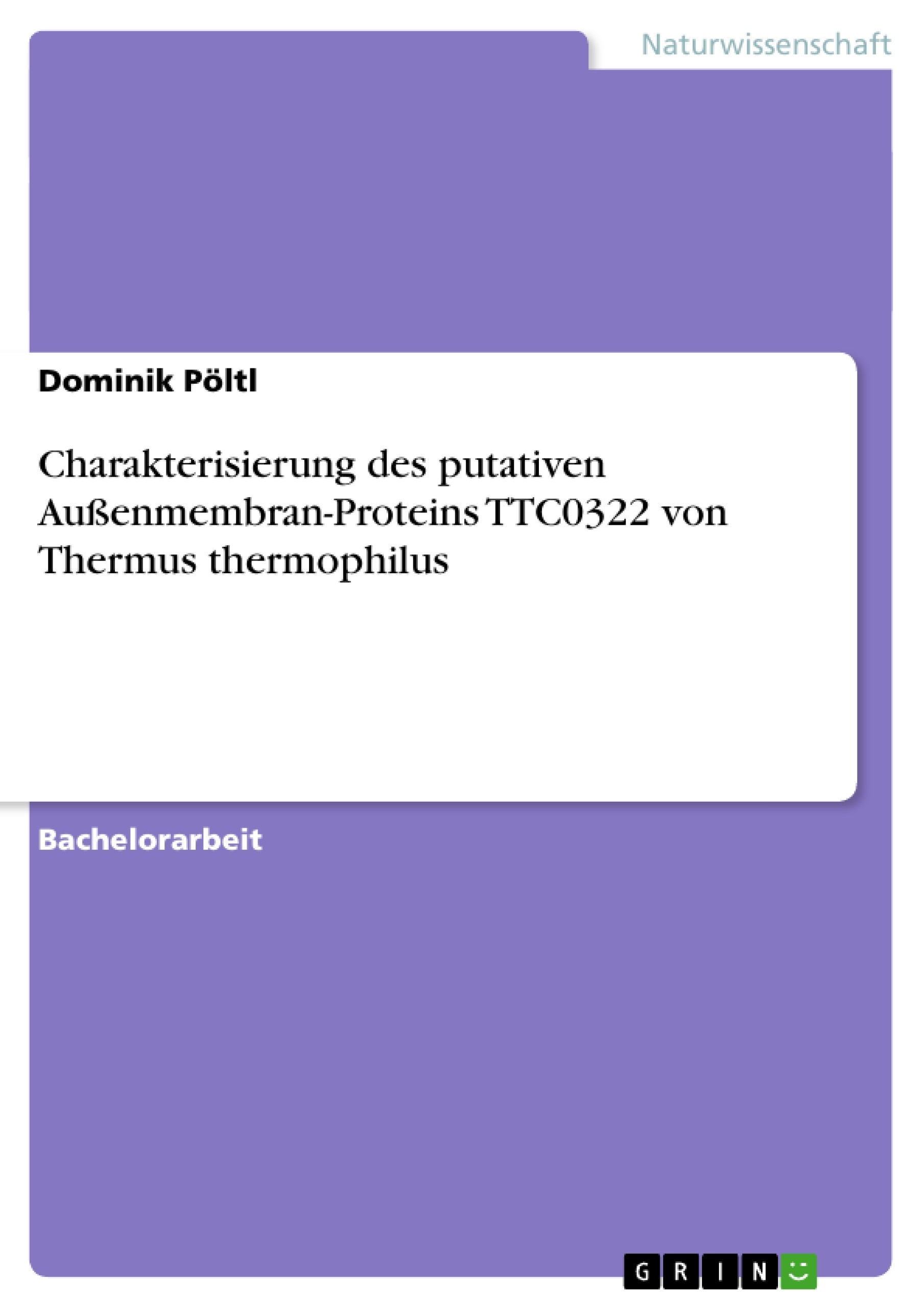Leseprobe
Inhaltsverzeichnis
Abbildungsverzeichnis
Tabellenverzeichnis
Abkürzungsverzeichnis
1 Abstract
2 Zusammenfassung
3 Einleitung
3.1 Thermus thermophilus: Das Bakterium
3.2 Carbohydrat-Aufnahme vonT. thermophilus6
3.3 Hinweise für ein energetisierendes System im Operon, das für Glucose-
Aufnahme codiert
3.3.1 Energetisierungssysteme ExbB/ExbD und Tol/Pal
3.4 Modellvorstellung zur Funktion von TTC0322
3.5 Zielsetzung dieser Arbeit
4 Material und Methoden
4.1 Bakterienstämme
4.2 Plasmide
4.3 Antikörper
4.4 Medien
4.5 Wachstumsbedingungen
4.6 Bestimmung der optischen Dichte
4.7 Molekularbiologische Methoden
4.7.1 PCR
4.7.2 Restriktionsverdau, Auffüllen überstehender Enden und Dephos- phorylierung
4.7.3 Ligation
4.7.4 Reinigung von DNA-Fragmenten
4.7.5 Plasmidpräparation
4.7.6 Präparation chromosomaler DNA
4.7.7 Transformation vonE. coli19
4.7.8 Transformation vonThermus thermophilus20
4.7.9 Agarose-Gel-Elektrophorese/Ethidiumbromidfärbung
4.7.10 DNA-Sequenzierungen
4.8 Biochemische Methoden
4.8.1 SDS-Polyacrylamid-Gel-Elektrophorese
4.8.2 Färbung von Polyacrylamid-Gelen
4.8.3 Western-Blot
4.8.4 Proteinexpression
4.8.5 Gesamtzellextrakt
4.8.6 Sucrosegradientenzentrifugation
4.8.7 BCA Protein-Assay
4.8.8 Transportassay
4.9 Bioinformatische Analyse-Software
5 Ergebnisse
5.1 Eine TTC0322-Mutante kann nicht mehr auf Glucose wachsen, obwohl Glucose besser transportiert wird als durch den Ausgangsstamm
5.1.1 Herstellung eines Plasmids zur Konstruktion einer chromosoma- len Insertionsmutante
5.1.2 Herstellung einer chromosomalen Insertionsmutante DP1
5.1.3 Charakterisierung der TTC0322-Mutante
5.2 Versuch, die Lokalisation des Proteins TTC0322 herauszufinden
5.2.1 Herstellung der Expressionsplasmide pDP2 und pDP3
5.2.2 Expression von TTC0322-His inE. coli37
5.2.3 Expression von TTC0322-His inT. thermophilus38
5.2.4 Zellfraktionierung vonT. thermophilus38
5.3 Bioinformatische Analysen
6 Diskussion
Literaturverzeichnis
Abbildungsverzeichnis
3.1 ABC-Transporter inT. thermophilus6
3.2 Lage im Operon
3.3 ExbB/ExbD-System
3.4 Tol/Pal-System
3.5 Modellvorstellung zu TTC0322
5.1 Kontroll-Verdau von pTOPO-TTC0322::bleo29
5.2 pDP1
5.3 Doppelt homologe Rekombination
5.4 PCR Mutante
5.5 Wachtum auf den Minimalmedien-Platten
5.6 Transportassay
5.7 Kontroll-Verdau pDP2 und pDP3
5.8 pDP2 und pDP3
5.9 Western-Blot der Expression von TTC0322-His in BL21-AI
5.10 Sucrosegradient-Gele
5.11 Operon-Vergleich vonT. thermophilusundD. radiodurans
5.12 Gefundene Promoterstruktur in der intergenen Region III
Tabellenverzeichnis
4.1 Bakterienstämme
4.2 Plasmide
4.3 Antiseren für Western-Blot
4.4 Medien
4.5 Primer
4.6 PCR-Ansatz
4.7 Puffer für chemisch kompetente Zellen
4.8 Lösungen für Coomassie-Färbung
4.9 Lösungen für Silberfärbung
4.10 Lösungen für Western-Blot
4.11 Radioaktiv markierte Zucker
4.12 Bioinformatik-Software
5.1 Wachstumsplatten
5.2 Wachstums-Ergebnisse
5.3 Aufnahmeraten von[14]C-Glc
Abkürzungsverzeichnis
Abbildung in dieser Leseprobe nicht enthalten
1 Abstract
The bacteriumThermus thermophiluslives in hot thermal springs and has potential importance for biotechnology [18], as it contains thermostable proteins. In this study the characterization of the protein TTC0322 was initiated. Bioinforma- tical research predicts either a localization in the periplasm or in the outer membrane. Considering the localization on the chromosome, upstream genes encode for an ABC- transporter for glucose and an energizing system like ExbB/ExbD or Tol/Pal. This led to the model of a function of TTC0322 in the active uptake of glucose across the outer membrane. In this model TTC0322 is an active outer membrane transporter for gluco- se, which is activated by the putative energizing proteins encoded by the three direct upstream genes. To test the model a TTC0322-knockout-mutant was constructed by inserting a bleomycin-resistence-cassette into the gene TTC0322. In a following pheno- typically characterization it was found that TTC0322 is essential for growth on glucose, but not for other sugars. Nevertheless, our hypothesis was disapproved, because the knockout-mutant continued transporting glucose. Besides, by knocking out TTC0322, the glucose-ABC-transport-system was constitutively present, which normally is regu- lated through presence of glucose. That implicates a regulatory effect of TTC0322 on induction. Whether this effect is primarily related to this protein itself or carried out by some second protein influenced through it, was not determined. At this point, a conclusion about the exact role of TTC0322 inT. thermophilusis not possible. Furthermore I tried to express a his-tagged version of TTC0322 inE. coliand T. thermophilusin order to purify it and start some localization studies with it. Low expression only worked inE. coli, whereasT. thermophilusshowed no expression, making it impossible to purify the protein or localize it in cellular extracts ofT. thermophilus. Additionally there were efforts made to localize the protein by cell-fractionatingT. thermophiluswild-type and TTC0322 mutant strains. However, this method was unsuggestive of the localization of TTC0322.
By using some bioinformatic research tools extensively in order to find out other hints on this proteins function, it could be shown that the encoding gene isn’t necessarily located in one operon with the glucose-ABC-transporter-genes, since another promoter in front of these genes was found. It might form an own operon, including only additional the genes for the energizing system.
Another interesting observation alongside these experiments is that MalK, which is known as the ATP-hydrolyzing subunit of both ABC-transporters for glucose and maltose, might also be part of a so far unknown fructose-ABC-transporter. Experiments showed that a knockout-mutant ofmalKlost its ability to grow on fructose.
[...]
- Arbeit zitieren
- Dominik Pöltl (Autor:in), 2006, Charakterisierung des putativen Außenmembran-Proteins TTC0322 von Thermus thermophilus, München, GRIN Verlag, https://www.grin.com/document/195512
Kostenlos Autor werden






















Kommentare